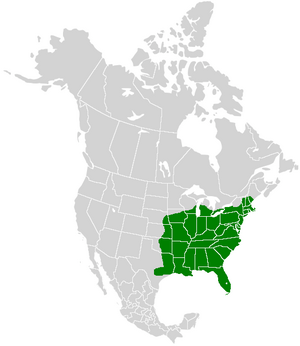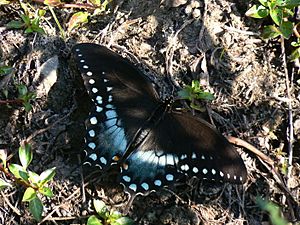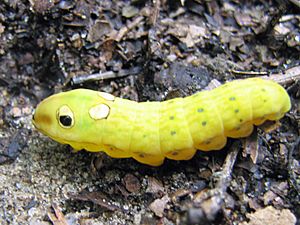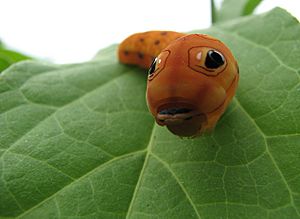Spicebush swallowtail facts for kids
Quick facts for kids Spicebush swallowtail |
|
|---|---|
 |
|
| Conservation status | |
| Scientific classification | |
| Genus: |
Papilio
|
| Species: |
troilus
|
| Subspecies | |
|
|
 |
|
The spicebush swallowtail (scientific name: Papilio troilus) is a common black butterfly. You might also hear it called the green-clouded butterfly. These beautiful insects live in North America.
There are two main types, or subspecies, of the spicebush swallowtail: Papilio troilus troilus and Papilio troilus ilioneus. The second type mostly lives in Florida. This butterfly gets its name from a plant it loves to eat, the spicebush.
Spicebush swallowtails belong to a family of butterflies called Papilionidae. This family includes some of the biggest butterflies in the world! A cool fact about swallowtails is that they keep fluttering their wings even when they are drinking nectar. Unlike many other swallowtail butterflies, spicebush swallowtails usually fly close to the ground, not high up in the air.
Contents
Where Do Spicebush Swallowtails Live?
The spicebush swallowtail mainly lives in the eastern United States and southern Ontario, Canada. Sometimes, they fly to other places like the American Midwest, Cuba, Manitoba, and Colorado.
When they are young caterpillars, they stay on the leaf where they hatched. But adult butterflies can fly anywhere within their home range. They mostly look for water, nectar (their food), and other spicebush swallowtails to mate with.
You can often find these black butterflies in forests with trees that lose their leaves in fall. They also like woody swamps. They fly low and fast through shady spots. Female butterflies tend to stay in open fields, while males are often found in swampy areas.
The P. t. troilus Subspecies
This type of spicebush swallowtail is found across the Eastern United States. Their range goes from New England all the way to Wisconsin, and west to Illinois, North Dakota, and Nebraska. They are also common in Texas and Colorado.
The temperature might affect where P. t. troilus can live. They don't do well in very hot weather (above 36°C or 97°F). They also struggle in cold temperatures (below 14°C or 57°F).
The P. t. ilioneus Subspecies
This smaller type of spicebush swallowtail lives in the southeastern coastal United States. You can find them mostly in Florida, along the coast of Georgia, and in some parts of Texas.
What Do Spicebush Swallowtails Look Like?
Appearance of P. t. troilus
Spicebush swallowtails usually have a wingspan of about 3 to 4 inches (7.5 to 10 cm). Adult butterflies are mostly black or brown. They have a special half-moon shaped patch on their hindwings. This patch is green-blue on males and bright blue on females.
Their front wings have a border of cream-colored, oval spots. In the middle of the wing, some spots can be moon-shaped and light blue. Both male and female butterflies have cream-yellow, moon-shaped spots on the edges of their hindwings. They also have a bright orange spot at the base of their wings. In summer, the orange spot on females might turn a greenish-white color, but not in spring.
If you look at the underside of their hindwing, you'll see two rows of orange spots. This helps tell them apart from the pipevine swallowtail, which only has one row of spots. Between these rows, there is more blue or green coloring.
Appearance of P. t. ilioneus
The main color difference between the two types is on their hindwings. The P. t. troilus has blue spots, while the P. t. ilioneus has more yellow spots. Also, the P. t. ilioneus can have splashes of blue that go all the way down its tail.
What Do Spicebush Swallowtails Eat?
Spicebush swallowtail caterpillars mostly eat leaves from spicebush or white sassafras plants. They can also eat leaves from other plants like prickly ash, tulip tree, sweetbay, camphor, and redbay.
The P. t. ilioneus type mainly eats redbay and swampbay plants. The P. t. troilus type mostly eats spicebush and sassafras. However, if P. t. troilus caterpillars are given a choice between spicebush and sassafras, they don't seem to prefer one over the other.
Spicebush swallowtails really like plants from the Lauraceae family. They are so picky that if they are only given leaves from other plant families, they might not eat anything and could die. This is interesting because most other swallowtail butterflies are not nearly as choosy about their food.
Being so picky has its benefits! Spicebush swallowtails can eat and grow much better on Lauraceae plants than other butterflies that also eat these plants. No other insect has been found to eat spicebush as well as the spicebush swallowtail.
Adult spicebush swallowtails drink nectar from many different flowers. Some of their favorites include Joe-Pye weed, jewelweed, and honeysuckle. They also enjoy nectar from lantanas, thistles, milkweeds, azalea, dogbane, mimosa, and sweet pepperbush.
Life Cycle of the Spicebush Swallowtail
When a female spicebush swallowtail is ready to lay eggs, she often taps a leaf with her front legs. Her front legs have special sensors that help her check the leaf's chemicals. This helps her decide if it's a good place to lay her eggs.
The eggs are greenish-white and quite large. The female lays one or two eggs at a time on a spicebush leaf. When a young caterpillar hatches, it chews a section of the leaf. Then, it spins silk on the midrib of the leaf. As the silk dries, it pulls the leaf around the caterpillar, making a cozy shelter.
Young caterpillars are brownish, even if they are on a green leaf. This brown color helps them hide. During the day, they stay inside their leaf shelter to avoid predators. They come out at night to eat. If a caterpillar is disturbed in its rolled-up leaf, it can release a bad-smelling liquid to scare off attackers.
As caterpillars grow older, they turn greenish-yellow before they change into a pupa. Older caterpillars also live in a rolled-up leaf, which they line with silk. When it's time to become a pupa, the caterpillar leaves its shelter. It finds the underside of a leaf near the ground. It spins silk to attach itself to the branch or leaf. Then, it spins more silk to create a "safety harness" for its transformation.
The pupae (plural of pupa) can be either brown or green. They turn brown in winter and green in summer. This color change is called seasonal polyphenism. It helps the pupa blend in with the colors of the leaves around them. Leaves turn brown in winter and green in summer, so the pupa matches its surroundings.
Spicebush swallowtails usually have about three generations each year. Most of them become adults between February and November. The whole process from egg to adult takes about one month. Once they are adults, they can live from two days to two weeks. How long they live depends on how much food they find and how well they avoid predators.
How Do Spicebush Swallowtails Behave?
Spicebush swallowtails, along with another butterfly called P. palamedes, are good at controlling their body temperature. Their darker bodies and wings help them do this. This means they can fly and feed even when it's cooler than other butterfly species.
Social Behavior
Spicebush swallowtails often gather in groups, a behavior called puddling. This happens when adults are flying around looking for food or mates. When they puddle, they tend to stay together. You can often find these groups on the banks of water, like sandy or wet areas. They drink moisture from the soil or sand near the water.
Mating Behavior
Both male and female spicebush swallowtails often mate with several partners during mating season. However, after a female mates, she is less likely to mate again.
When spicebush swallowtails mate, they use visual signals to communicate. Males use fancy courtship dances to find females. During these dances, the male and female are often touching, which helps them share information. The male butterfly also releases special scents called pheromones around the female. The female uses her sense of smell to decide if she wants to mate.
Females are often found in sunny areas outside the treeline. This might be because the direct sunlight helps keep their bodies warm. Males don't worry as much about direct sunlight during mating because their bodies warm up from their energetic courtship dances. Males might perform these dances for females resting on plants or for those flying freely.
Parental Care
Once the eggs are laid, the adult spicebush swallowtails do not care for their young anymore. However, the eggs are full of nutrients, which helps the young caterpillars grow well. Also, female butterflies are very careful about choosing the right plant to lay their eggs on. This helps the eggs develop successfully.
Predators and How They Stay Safe
Who Eats Spicebush Swallowtails?
Many animals like to eat spicebush swallowtails. These include birds, spiders, robber flies, and dragonflies. These predators will try to eat both adult butterflies and young caterpillars. When threatened, spicebush swallowtails can also drop red liquid drops.
How They Mimic Other Animals
The main way spicebush swallowtails avoid being eaten is by mimicry. This means they pretend to be something else. Both types of spicebush swallowtails (P. troilus troilus and P. troilus ilioneus) and both sexes can mimic other things as caterpillars and as adults.
Caterpillar Mimicry
Spicebush swallowtail caterpillars have two ways of mimicking things. When they are young, they are dark brown. This makes them look like bird droppings, which helps predators ignore them.
When the caterpillars are older and almost ready to turn into a pupa, they change to a yellow-green color. They also have two big black spots with white centers on their swollen bodies. These spots make the caterpillars look like common green snakes! Looking like a snake helps scare away predators, especially birds. The caterpillars even act like snakes by "rearing up and pulling back their actual head."
The caterpillar's osmeterium also helps it look more like a snake. This is a Y-shaped organ that is usually hidden inside the caterpillar. When attacked, the caterpillar pushes out its osmeterium. For many spicebush swallowtails, this organ is red, making it look even more like a snake's tongue.
Adult Mimicry
Adult spicebush swallowtails also use mimicry. They look like the pipevine swallowtail (Battus philenor), a butterfly that tastes bad to predators. Both male and female spicebush swallowtails are good at looking like the pipevine swallowtail. Even though the blue color on female spicebush swallowtail wings is a bit brighter, they still fool predators.
Since spicebush swallowtails don't taste bad, but pipevine swallowtails do, this is called Batesian mimicry. If predators learn that pipevine swallowtails taste awful, they will avoid eating them. And because spicebush swallowtails look so similar, predators will also avoid eating them! Other butterflies also mimic the pipevine swallowtail, but the spicebush swallowtail looks the most like it.
Besides mimicry, another way spicebush swallowtails avoid predators is with the "club-like extensions from their hind-wings." If a predator attacks these "false heads," the butterfly itself remains safe, even if its wings get a little damaged.
Images for kids








